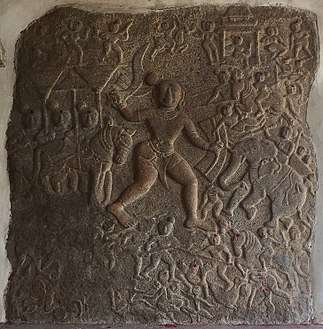Rajendra Chola I
Rajendra Chola I or Rajendra I was a Tamil Chola emperor of South India (present day Tamil Nadu, Andhra pradesh, Kerala, Karnataka and Telangana) who succeeded his father Rajaraja Chola I to the throne in 1014 CE. During his reign, he extended the influence of the Chola empire to the banks of the river Ganga in North India and across the Indian ocean to the West and South East Asia, making the Chola Empire one of the most powerful maritime empires of India.[7][8] Rajendra's conquests included Sri Lanka, Maldives, and he successfully invaded the territories of Srivijaya in Malay Peninsula, Southern Thailand, Sumatra and Java in South East Asia.[7][9] The Cholas exacted tribute from Thailand and the Khmer kingdom of Cambodia. He defeated Mahipala, the Pala king of Gauda in present-day Bengal and Bihar, and to commemorate his victory he assumed the title of 'Gangaikondachola',[10] literally the Chola who conquered the (kingdoms near) Ganga and also built a new capital city called Gangaikonda Cholapuram.[11][12]
| Rajendra Chola I | |
|---|---|
| Parakesari, Yuddhamalla, Mummudi, Gangai Kondan, Kadaram Kondan[2] | |
| Reign | c. 1014 – c. 1044 CE[5] |
| Predecessor | Rajaraja I |
| Successor | Rajadhiraja Chola I |
| Died | 1044 CE Brahmadesam, North Arcot district, Tamil Nadu[6] |
| Burial | Brahmadesam, North Arcot district, Tamil Nadu[6] |
| Consort | Tribhuvana Mahadeviyar Pancavan Madeviyar Viramadevi |
| Issue | Rajadhiraja Chola I Rajendra Chola II Virarajendra Chola Arulmolinangayar Ammangadevi |
| Dynasty | Chola Dynasty |
| Father | Rajaraja Chola |
| Mother | Thiripuvana Madeviyar |
| Religion | Hinduism |
| List of Chola kings and emperors | ||||||||||||||||||||||||||||
|---|---|---|---|---|---|---|---|---|---|---|---|---|---|---|---|---|---|---|---|---|---|---|---|---|---|---|---|---|
| Early Cholas | ||||||||||||||||||||||||||||
| Interregnum (c. 200 – c. 848) | ||||||||||||||||||||||||||||
| Medieval Cholas | ||||||||||||||||||||||||||||
|
||||||||||||||||||||||||||||
| Later Cholas | ||||||||||||||||||||||||||||
|
||||||||||||||||||||||||||||
| Related dynasties | ||||||||||||||||||||||||||||
|
||||||||||||||||||||||||||||
| Chola society | ||||||||||||||||||||||||||||
Early life and ascension
Rajendra Chola I was the son of Rajaraja Chola and Thiripuvana Madeviyar, princess of Kodumbalur. He was born in the Tamil month of Marghazi under star Thiruvathirai.[13] He spent most of his childhood in Palayarai and was brought up by his aunt Kundavai and great-grandmother Sembiyan Mahadevi. He was made the co-regent in 1012 CE. Rajendra formally ascended the Chola throne in 1014 CE. In 1018 CE, he installed his eldest son Rajadhiraja Chola I as the crown prince.[14]
Military conquests
Early campaigns
Rajendra led campaigns from 1002 CE. These include the conquest of the Rashtrakutas and the campaigns against the Western Chalukyas. He conquered the Chalukyan territories of Yedatore (a large part of the Raichur district between the Krishna and the Tungabhadra), Banavasi in the north-west of Mysore and capital Manyakheta. Rajendra erected a Siva temple at Bhatkal. In 1004 CE, he captured Talakad and overthrew the Western Ganga dynasty which had ruled over Mysore for almost 1000 years. He also conquered Kollipakkai, located to the north of Hyderabad in present-day Telangana. An excerpt from an inscription in Tamil from Kolar states:
In the 8th year of the reign of Kopparakesarivanmar sri Rajendra Sola Deva, who, while the goddess of Fortune, having become constant, increased, and while the goddess of the great Earth, the goddess of victory in battle and the matchless goddess of Fame, having become his great queens, rejoiced-that in his extended lifetime, conquered with his great war-like army Idaiturai-nadu, Vanavasi shut in by a fence of continuous forests; Kollipakkai, whose walls were surrounded by sulli trees; Mannaikkadakkam whose fortification was unapproachable.[15]
Conquest of Sri Lanka

Raja Raja Chola I conquered the northern half of Sri Lanka during his reign. Rajendra invaded Ceylon in 1017 CE and annexed the entire island.[16] As a result of the campaign, Rajendra captured the regal jewels of the Pandyas, which Parantaka I tried to capture and the crown of the Sinhala king. The Sinhala king Mahinda V was taken prisoner and transported to the Chola country.
Pandyas and Cheras
In 1018/19 CE, Rajendra marched into the Pandya and Chera Perumal kingdoms and conquered the two countries.[14] Rajendra appointed one of his sons as viceroy with the title Jatavarman Sundara Chola-Pandya with Madurai as the headquarters (in-charge both Pandya and Chera/Kerala countries).
Chalukyan conflict
In 1015 CE, Jayasimha II became the king of Western Chalukyas. He tried to recover the losses suffered by his predecessor Satyashraya, who fled his capital and was later restored to the throne by Raja Raja I as a tribute paying subordinate. Initially, Jayasimha II was successful as Rajendra was busy with his campaigns in Sri Lanka.[17] In 1021 CE, after the demise of the Eastern Chalukyan king Vimaladitya of Vengi, Jayasimha supported the claim of Vijayaditya VII to the throne against the claims of Rajaraja Narendra. Rajaraja Narendra was the son of Vimaladitya and Chola princess Kundavai.[17] Rajendra helped his nephew Rajaraja defeat Vijayaditya.[18] His armies defeated Vijayadiya in Vengi and Jayasimha in the battle of Maski.[17]
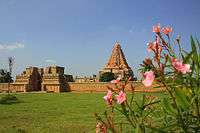
Expedition to the Ganges
In 1019 CE, Rajendra's forces marched through Kalinga towards the river Ganga. In Kalinga the Chola forces defeated Indraratha the ruler of the Somavamsi Dynasty.[19] The Chola army eventually reached the Pala kingdom of Bengal where they defeated Mahipala. The Chola army also defeated the last ruler of the Kamboja Pala dynasty Dharmapala of Dandabhukti.[20][21] The Chola army went on to raid East Bengal and defeated Govindachandra of the Chandra dynasty and invaded Bastar region.[22][23] The territories held the status of tribute paying subordinates and trade partners with the Chola Kingdom, an arrangement that lasted till the times of Kulothunga III.[24] He constructed a new capital at Gangaikondacholapuram and built the Brihadeeswarar Temple similar to the Brihadeeswarar Temple at Thanjavur.
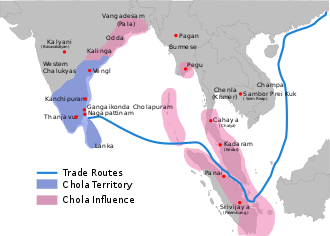
South East Asian expedition
Srivijaya was a kingdom centered on Palembang in Sumatra, ruled by the Sailendra dynasty. During the reign of Mara Vijayatungavarman, Srivijaya had cordial relations with the Chola Empire during the reign of Rajaraja Chola I; Mara Vijayatungavarman built a Chudamani Vihara at Nagapattinam. Mara was succeeded by Sangrama Vijayatunggavarman.
Khmer Emperor Suryavarman I made war on the kingdom of Tambralinga (in the Malay Peninsula). Suryavarman I requested aid from Rajendra.[25][26] After learning of Suryavarman's alliance with Rajendra Chola, Tambralinga requested aid from Srivijaya, which was granted by Sangrama.[25][27] This eventually led to the Chola expedition against the Srivijiya Empire. This alliance somewhat also had a religious nuance, since both the Chola Empire and the Khmer Empire were Hindu Shivaist, while Tambralinga and Srivijaya were Mahayana Buddhist.
In 1025 CE, Rajendra led Chola forces across the Indian Ocean and invaded Srivijaya, attacking several places in Malaysia and Indonesia.[28] The Chola sacked Kadaram (the capital) and Pannai in Sumatra and Malaiyur in the Malay Peninsula. Rajendra also invaded Tambralinga and the Langkasuka Kingdom in modern Malaysia and south Thailand.[12][29][30] The Chola forces captured the last ruler of the Sailendra Dynasty Sangrama Vijayatunggavarman.[31] The Chola invasion was the end of Srivijaya.[32][33] Srivijaya's maritime power declined under Chola attack.[34] After this the Chola Empire conquered large portions of Srivijaya, including its ports of Ligor, Kedah, and Tumasik (now Singapore).[34][35] The Chola invasion furthered the expansion of Tamil merchant associations such as the Manigramam, Ayyavole, and Ainnurruvar into Southeast Asia.[36][37][38][39] For the next century, Tamil trading companies from southern India dominated Southeast Asia.[32][33] The expedition of Rajendra Chola I is mentioned in the corrupted form as Raja Chulan in the medieval Malay chronicle Sejarah Melaya, and Malay princes have names ending with Cholan or Chulan, such as Raja Chulan of Perak.[40][41][42][43][44] One record of Rajendra Chola describes him as the King of Lamuri in north Sumatra.[45] The Chola invasion led to the fall of the Sailendra Dynasty of Srivijaya and the Chola invasion also coincides with the return voyage of the great Buddhist scholar Atiśa from Sumatra to India in 1025.[46]
Work and legacy
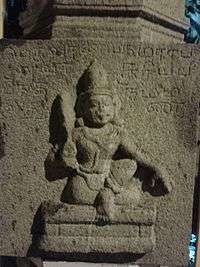
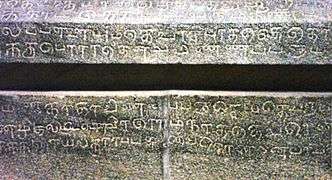
Rajendra Chola built a vast artificial lake, sixteen miles long and three miles wide which was one of the largest man-made lakes in India.[48] The fortified capital of Rajendra Chola was of impressive grandeur and Ottakoothar states, On seeing Gangapuri, all fourteen worlds encircled by the billowing ocean are overwhelmed with joy.[48][49] The extent of the empire was the widest in India and the military and naval prestige was at its highest.[50] The successful invasions of Rajendra Chola were applauded by several medieval Tamil poets like Jayamkondan in his text Kalingattupparani and Ottakkoothar in his text Ula.[51]
After his successful campaign to Ganges river in north India he got the title Gangaikonda Chola (The Chola who took the Ganges river). And after his successful Southeast Asian campaign he got the title "Kadaram Kondan"(He who took Kedah in Malaysia).[51] He founded a new capital city called Gangaikonda Cholapuram and built a Shiva temple similar to the Thanjavur Brihadisvara temple built by his father Rajaraja Chola. He expanded the Pathirakali Amman Temple and Koneswaram temple of Trincomalee.[48] He inherited the title Mummudi Cholan (Chola with three crowns) from his father with Mummudi, a title used by Tamil kings who ruled the three kingdoms of Cholas, Pandyas and Cheras.[52] To commemorate his conquests, Rajendra assumed other titles such as Mudigonda Cholan and Irattapadikonda Cholan.
The Malay-language Hikayat Iskandar Zulkarnain was written about Alexander the Great as Dhul-Qarnayn and from it the ancestry of several Southeast Asian royal families is traced to Iskandar Zulkarnain,[53] through Rajendra Chola (Raja Suran, Raja Chola) in the Malay Annals, such as the Sumatran Minangkabau royalty.[54][55]
Personal life and family
Rajendra Chola had many consorts including Tribuvana or Vanavan Mahadeviar, Mukkokilan,Arindhavan Madevi and Viramadevi, last of whom committed sati upon Rajendra Chola's death. The Siddanta Saravali of Trilochana Sivacharya states that Rajendra was a poet and he composed hymns in praise of Shiva. A commentary on the same work states that Rajendra Chola brought a number of Saivas from the banks of the Ganges and settled them in Kanchi and the Chola country.[56] Rajendra Chola had three sons namely Rajadhiraja Chola, Rajendra Chola II and Virarajendra Chola, who followed him on the Chola throne in succession. He had two daughters Pranaar Arul Mozhi Nangai and Ammanga Devi. His campaigns were led by general Senapati Narakkan Sri Krishnan Raman.[57][58] Another notable minister of Madhuranthaka or Rajendra Chola as per his Tiruvalangadu plates, who assisted him in several of his campaigns, was nobleman Jananatha, described as the son of a person called Rama. He bore the title Chalukya-Chudamani, that is crest-jewel-of-the-Chalukyas.[59]
Death
According to South Indian epigraphs and records, Rajendra Chola I died in Brahmadesam now a part of North Arcot district in Tamil Nadu, India. This information is recorded in an inscription of his son, Rajadhiraja Chola I which states that Rajendra Chola's queen Viramadeviyar committed Sati upon Rajendra's death and her remains were interred in the same tomb as Rajendra Chola I in Brahmadesam. It adds that the queen's brother, sēnapati Madhurantakan Parakēsari vēlān,[60] who was a general in Rajendra Chola's army set up a watershed at the same place in memory of his sister.[6][61]
Inscriptions

An inscription of the king from the Adhipuriswara temple in Chengalpattu district gives his natal star as Tiruvadarai. Donations were made to the temple to celebrate the king's birthday in the month of Maargali.[62] Another inscription from the Umamahesvara temple in Konerirajapuram, Thanjavur district refers to the donations by Alvar Parantakan Kundavai-Pirattiyar during the third year of the king's reign.[63]
Popular culture
- India's navy training ship TS Rajendra was named in his honour.[64]
- Vengayin Maindhan by Akilan covers the life and achievements of Rajendra Chola
- Gangapuri Kavalan by Vembu Vikiraman in which Rajendra Chola is the protagonist
- Mannan Magal by Sandilyan set in the period of Rajendra Chola
- Gangai Konda Cholan by Balakumaran
- Ulagam Vendra Cholan by Bharathika which covers the War history and Life Achievements
- the state of Maharashtra proposed to dedicate Rajendra Chola's portrait to Mazgaon Docks[65]
See also
References
- Nagapattinam to Suvarnadwipa: Reflections on the Chola Naval Expeditions to Southeast Asia, Institute of Southeast Asian Studies, p.170
- Nagapattinam to Suvarnadwipa: Reflections on the Chola Naval Expeditions to Southeast Asia, Institute of Southeast Asian Studies, p.170
- "Culture causerati forget a 1000yr milestone". telegraphindia.com. Retrieved 28 July 2014.
- "Sculptures of Shiva in temples of South India". lakshmisharath.com. Retrieved 17 February 2015.
- Sen, Sailendra (2013). A Textbook of Medieval Indian History. Primus Books. pp. 46–49. ISBN 978-9-38060-734-4.
- Ē. Kē Cēṣāttiri. Sri Brihadisvara: The Great Temple of Thānjavūr. Nile Books, 1998. p. 19.
- Trade and Trade Routes in Ancient India by Moti Chandra p.213
- Advanced Study in the History of Medieval India by Jaswant Lal Mehta p.37
- Power and Plenty: Trade, War, and the World Economy in the Second Millennium by Ronald Findlay, Kevin H. O'Rourke p.67
- Satish., Chandra (2007). History of medieval India : 800-1700 page-29. Hyderabad, India: Orient Longman. ISBN 978-8125032267. OCLC 191849214.
- Cultural Sociology of the Middle East, Asia, and Africa: An Encyclopedia by Andrea L. Stanton, Edward Ramsamy, Peter J. Seybolt, Carolyn M. Elliott p.18
- The Sea and Civilization: A Maritime History of the World by Lincoln Paine p.866
- Topics in South Indian History: From Early Times Upto 1565 A.D. Topics in South Indian History: From Early Times Upto 1565 A.D. Krishnaswami, 1975. p. 169.
- See Sastri, K. A. N., A History of South India, p165
- Epigraphia Carnatica, Volume 10, Part 1, page 32
- Indian History with Objective Questions and Historical Maps Twenty-Sixth Edition 2010, South India page 59
- See Sastri, K. A. N., A History of South India, p166
- Proceedings of the Asiatic Society of Bengal, page 70
- Sastri, K. A. Nilakanta (2000) [1935]. The Cōlas. Madras: University of Madras. p.208
- Ancient Indian History and Civilization by Sailendra Nath Sen p.281
- West Bengal District Gazetteers: Nadīa p.63
- The Cambridge Shorter History of India p.145
- Dimensions of Human Cultures in Central India by Professor S.K. Tiwari p.161
- See Nilakanta Sastri, K. A. (1935). The CōĻas, pp 209 – 212. Sastri bases his argument on the fact that these regions were not included in the inscriptions of his successors, though successive Chola Kings from Rajaraja I to Kulothunga III have assumed titles as 'Kings who conquered Ilam', reinforcing the fact that off and on, rebellions were being quelled and Chola authority on the island of 'Ilangai' was maintained, despite a later king of Lanka sending an embassy to the Chola adversary Vikramaditya VI of the Chalukya dynasty, subsequent to which another expedition to Ilangai caused the Sinhala king to flee to Rohana hills on the South Coast of that country.
- Kenneth R. Hall (October 1975), "Khmer Commercial Development and Foreign Contacts under Sūryavarman I", Journal of the Economic and Social History of the Orient 18 (3), pp. 318-336, Brill Publishers
- Munoz, Paul Michel. Early Kingdoms of the Indonesian Archipelago and the Malay Peninsula p. 158-159
-
- Majumdar, R. C. (1961). "The Overseas Expeditions of King Rājendra Chola", Artibus Asiae 24 (3/4), pp. 338–342. Artibus Asiae Publishers.
- Coedès, George (1968). Walter F. Vella (ed.). The Indianized States of Southeast Asia. trans. Susan Brown Cowing. University of Hawaii Press. pp. 142–143. ISBN 978-0-8248-0368-1.
- Andaya, Leonard Y. Leaves of the Same Tree: Trade and Ethnicity in the Straits of Melaka p.35
- Epigraphia Carnatica, Volume 10, Part 1, page 41
- Kulke, Hermann; Kesavapany, K.; Sakhuja, Vijay. Nagapattinam to Suvarnadwipa: Reflections on the Chola Naval Expeditions to Southeast Asia p. 230
- Abshire, Jean. The History of Singapore p. 17
- Murfett, Malcolm H.; Miksic, John; Farell, Brian; Chiang, Ming Shun. Between Two Oceans: A Military History of Singapore from 1275 to 1971 p. 16
- Sar Desai, D. R. Southeast Asia: Past and Present p.43
- Munoz, p. 161
- Sen, Tansen. Buddhism, Diplomacy, and Trade: The Realignment of Sino-Indian Relations 600-1400 p. 159
- Findlay, Ronald; O'Rourke, Kevin H. Power and Plenty: Trade, War, and the World Economy in the Second Millennium p. 69
- Wink, André. Al-Hind, the Making of the Indo-Islamic World: Early Medieval India and the expansion of Islam 7th-11 centuries p. 325
- Sen, Sailendra Nath. Ancient Indian History and Civilization p. 564
- Gunn, Geoffrey C. History Without Borders: The Making of an Asian World Region, 1000-1800 p. 43
- Kulke, Hermann; Kesavapany, K.; Sakhuja, Vijay. Nagapattinam to Suvarnadwipa: Reflections on the Chola Naval Expeditions to Southeast Asia p. 71
- Sen, Tansen. Buddhism, Diplomacy, and Trade: The Realignment of Sino-Indian Relations p. 226
- Kalyanaraman, A. Aryatarangini, the Saga of the Indo-Aryans p.158
- Singam, S. Durai Raja. India and Malaya Through the Ages
- Wink, André. Al-Hind: The Slave Kings and the Islamic Conquest p. 326
- Atisa and Tibet: Life and Works of Dipamkara Srijnana by Alaka Chattopadhyaya p.91
- Rice, Benjamin Lewis (1994). Epigraphia Carnatica: Volume X: Inscriptions in the Kolar District. Mangalore, British India: Department of Archeology, Mysore State. Retrieved 4 August 2015.
- Art of the Imperial Cholas by Vidya Dehejia: p.79
- See Schmidt, K, p32
- Kulke, Hermann; Rothermund, Dietmar (1998). A history of India. Routledge. p. 109. ISBN 0-415-15482-0.
- Nagapattinam to Suvarnadwipa: Reflections on the Chola Naval Expeditions to .Southeast Asia by Hermann Kulke, K Kesavapany, Vijay Sakhuja p.170
- Temples of South India by V.V. Subba Reddy p.118
- Balai Seni Lukis Negara (Malaysia) (1999). Seni dan nasionalisme: dulu & kini. Balai Seni Lukis Negara.
- John N. Miksic (30 September 2013). Singapore and the Silk Road of the Sea, 1300_1800. NUS Press. pp. 147–. ISBN 978-9971-69-574-3.
- Marie-Sybille de Vienne (9 March 2015). Brunei: From the Age of Commerce to the 21st Century. NUS Press. pp. 47–. ISBN 978-9971-69-818-8.
- R. S. Sharma, K. M. Shrimali. A Comprehensive history of India: A.D. 985-1206, Volume 4, Part 1, A comprehensive history of India, K. K. Dasgupta. People's Publishing House, 1992. p. 14.
- South Indian shrines: illustrated, page 53
- Śrīnidhiḥ: perspectives in Indian archaeology, art, and culture : Shri K.R. Srinivasan festschrift, page 358
- N. Subrahmanian. Tamil Epigraphy: A Survey. Ennes Publications, 1980. p. 128.
- Place Names Society of India. Madhav N. Katti (ed.). Studies in Indian place names, Volume 6. Published on behalf of the Place Names Society of India by Geetha Book House, 1984. p. 89.
- Place Names Society of India. Madhav N. Katti (ed.). Studies in Indian place names, Volume 6. Published on behalf of the Place Names Society of India by Geetha Book House, 1984 - India. p. 89.
- S. R. Balasubrahmanyam. Middle Chola Temples: Rajaraja I to Kulottunga I, A.D. 985-1070. Thomson Press (India), 1975 - Hindu temples - 424 pages. p. 301.
- S. R. Balasubrahmanyam. Middle Chola Temples: Rajaraja I to Kulottunga I, A.D. 985-1070. Thomson Press (India), 1975. p. 269.
- "Press release, President address". Government of India. Retrieved 1 June 2016.
- "Rajendra Chola: Maharashtra to dedicate Tamil emperor Rajendra Chola's portrait to Mazgon Docks". The Times of India. 29 September 2016. Retrieved 11 January 2018.
Further reading
- Schmidt, Karl Ludwig (1997). An Atlas and Survey of South Asian History (Sources and Studies in World History). Armonk, N.Y: M.E. Sharpe. ISBN 1-56324-334-2.
- R. Hall, Kenneth (October 1975). Khmer Commercial Development and Foreign Contacts under Sūryavarman I, Journal of the Economic and Social History of the Orient 18 (3), pp. 318–336. Brill Publishers
- Śrīnidhiḥ: perspectives in Indian archaeology, art, and culture by K. R. Srinivasan, K. V. Raman
| Wikimedia Commons has media related to Rajendra Chola I. |
| Preceded by Rajaraja Chola I |
Chola dynasty 1012–1044 CE |
Succeeded by Rajadhiraja Chola |
